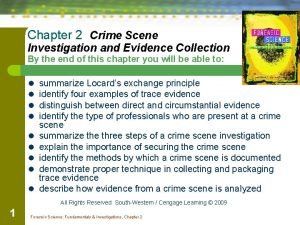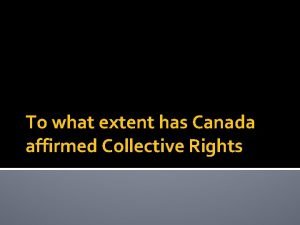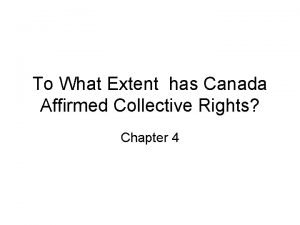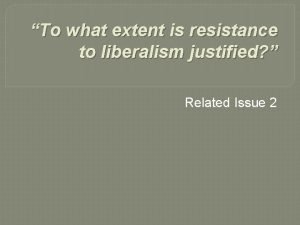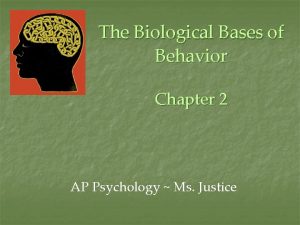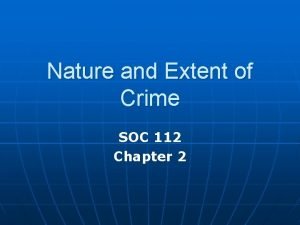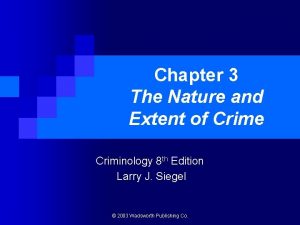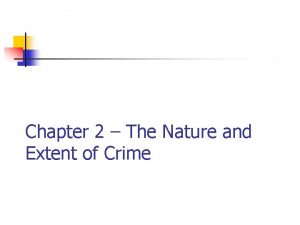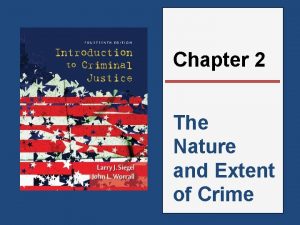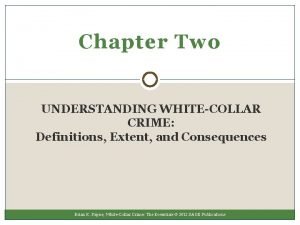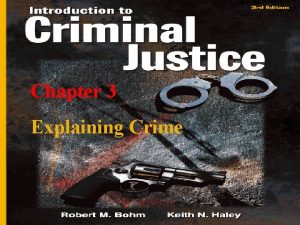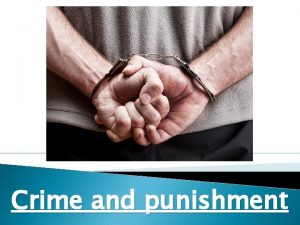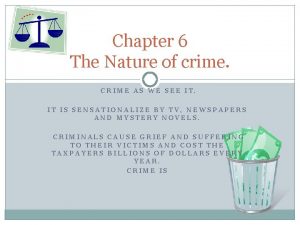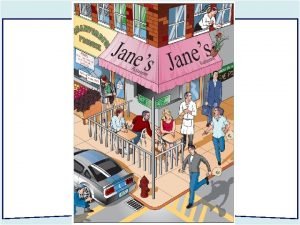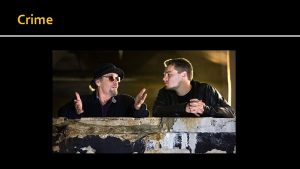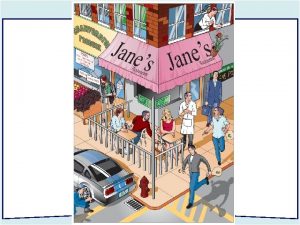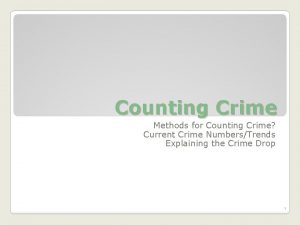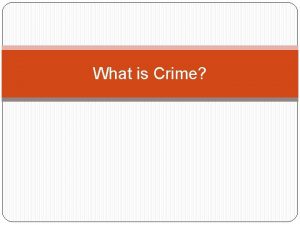Chapter Two The Nature and Extent of Crime



























- Slides: 27

Chapter Two The Nature and Extent of Crime

Learning Objectives Discuss how crime is defined ➤ Define and discuss some of the different types of crime ➤ Explain the methods used to measure crime ➤ Discuss the development of the NIBRS program ➤

Learning Objectives Discuss the strengths and weaknesses of various measures of crime ➤ Recognize the trends in the crime rate ➤ Summarize the various crime patterns ➤ Explain the problem of chronic offending ➤

How Crime is Defined ➤ Consensus View ➤ ➤ The view that certain behaviors must be outlawed or controlled, and that criminal law is designed to protect citizens from social harm Conflict View ➤ The law is the instrument that enables the wealthy to maintain their position of power and control the behavior of those who oppose their ideas and values or who might rebel against the unequal distribution of wealth

How Crime is Defined ➤ Interactionist View ➤ Criminal law is structured to reflect the preferences and opinions of people who hold social power in a particular legal jurisdiction

Thinking Point ➤ According to the interactionist view of crime, acts are illegal because they are defined that way by law. The issue on this Denver billboard is whether or not the state legalize marijuana for recreational use, regulating it like alcohol products. ➤ ➤ ➤ Why is smoking pot illegal and the consumption of alcohol legal? Are they really so different? Is it merely a matter of definition and labeling?

How Crime is Defined ➤ Though consensus, conflict, and interactionist views of crime differ, they generally agree that: ➤ ➤ Criminal law defines crime The definition of crime is constantly changing and evolving Social forces mold the definition of crimes Criminal law has a social control function

Definition of Crime

Thinking Point ➤ In 2012 Adam Lanza killed 20 children and 6 adults at Sandy Hook Elementary School in Newtown, CT. This is one of many school shootings that have taken place in the U. S. in the past 15 years. ➤ ➤ ➤ How was the crime covered by the media? How was the crime defined? What was the general consensus by the public in terms of Lanza’s mental state?

What are the Different Categories of Crime? ➤ Violent Crimes ➤ ➤ Gang violence Multiple murder Mass murders ➤ Spree killers ➤ Serial killers ➤ ➤ ➤ Intimate violence Hate crimes

Violent Victimization Reported and Not Reported to Police

Thinking Point ➤ Typically fear of victimization far exceeds one’s actual victimization potential. ➤ ➤ ➤ What are some of the factors that influence the gap between fear of crime and the reality of crime? How does the media influence our fear of crime? What influences your personal fear (or lack of fear) of crime?

What are the Different Categories of Crime? ➤ Property Crime – outnumbers violent crime by a margin of 7 to 1 ➤ ➤ Burglary Larceny

What are the Different Categories of Crime? ➤ Public Order Crimes ➤ ➤ ➤ Prostitution Substance abuse Economic Crimes ➤ ➤ White collar crime Organized crime

Sources of Crime Data ➤ The Uniform Crime Reports (UCR) ➤ ➤ Compiled by the FBI, this national survey compiles criminal acts reported to local police Part I crimes include: Murder ➤ Rape ➤ Burglary ➤ Robbery ➤ Assault ➤ Larceny-theft ➤ Motor vehicle theft ➤

Percentage of Crimes Cleared by Arrest

Sources of Crime Data ➤ National Incident-Based Reporting System (NIBRS) ➤ ➤ Requires local police agencies to provide at least a brief account of each incident and arrest, including the incident, victim, and offender information There are expanded crime categories, such as blackmail, embezzlement, drug offenses, and bribery

Sources of Crime Data ➤ National Crime Victimization Survey (NCVS) ➤ ➤ Surveys victims about their experiences with law violation Self-Report Surveys ➤ Asks offenders themselves to report about their criminal behaviors

Evaluating Sources of Crime Data

Crime Trends in Violent Crime and Property Crime ➤ Trends in Victimization ➤ Trends in Self-Reporting ➤

Crime Patterns ➤ The Ecology of Crime ➤ ➤ ➤ Day, season, and climate Regional differences Social Class, Socioeconomic Conditions, and Crime ➤ Explaining the class-crime relationship

Crime Patterns Age and Crime ➤ Gender and Crime ➤ Explaining Gender ➤ Differences in the Crime Rate ➤ ➤ ➤ Traits Socialization and development Cognitive differences Feminist views

Crime Patterns ➤ Race and Crime ➤ ➤ ➤ System bias Cultural bias Structural bias

Thinking Point How do you explain the gender differences in the crime rate? ➤ Are men more violent than women? ➤ ➤ If you believe men are more violent than women, does this mean there is a genetic component to crime?

Crime Patterns ➤ Chronic Offending and Crime ➤ ➤ What causes chronicity? Policy implications Three-strikes ➤ Truth-in-sentencing ➤

Distribution of Offenses in the Philadelphia Cohort

Thinking Point ➤ A career criminal is by definition a persistent repeat offender who organizes their lifestyle around criminality. Policies such as three-strikes laws and truth-in-sentencing have become central crime control policies to target the career criminal, however are applied to many other offenders as well. ➤ ➤ Do you support these get-tough strategies? Why or why not? What are possible negative consequences of these crime control strategies?
 What is the nature and extent of juvenile delinquency
What is the nature and extent of juvenile delinquency Nature and nature's law lay hid in night
Nature and nature's law lay hid in night Determinace lidské psychiky
Determinace lidské psychiky Chapter 7 deviance crime and social control
Chapter 7 deviance crime and social control The seven s's of crime scene investigation
The seven s's of crime scene investigation To what extent has canada affirmed collective rights?
To what extent has canada affirmed collective rights? British empire size
British empire size Non contrived setting
Non contrived setting Face validity definition
Face validity definition To what extent should we embrace globalization
To what extent should we embrace globalization Should internationalism be pursued
Should internationalism be pursued To what extent has canada affirmed collective rights
To what extent has canada affirmed collective rights To what extent should nation be the foundation of identity
To what extent should nation be the foundation of identity Apush essay prompts
Apush essay prompts To what extent should we embrace nationalism
To what extent should we embrace nationalism Is resistance to liberalism justified
Is resistance to liberalism justified Which bird can rotate its neck backwards to a large extent
Which bird can rotate its neck backwards to a large extent Beowulf study guide 1 answers
Beowulf study guide 1 answers Noncontrived
Noncontrived How do neurotransmitters influence behavior
How do neurotransmitters influence behavior To what extent adverbs
To what extent adverbs Wide extent
Wide extent Locally managed tablespace
Locally managed tablespace Analyse the extent
Analyse the extent Glycogen is found to only a limited extent in
Glycogen is found to only a limited extent in Hát kết hợp bộ gõ cơ thể
Hát kết hợp bộ gõ cơ thể Slidetodoc
Slidetodoc




